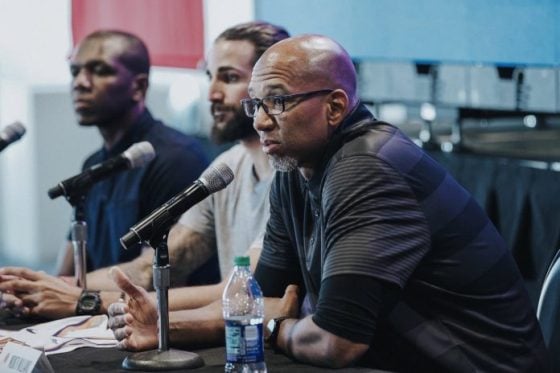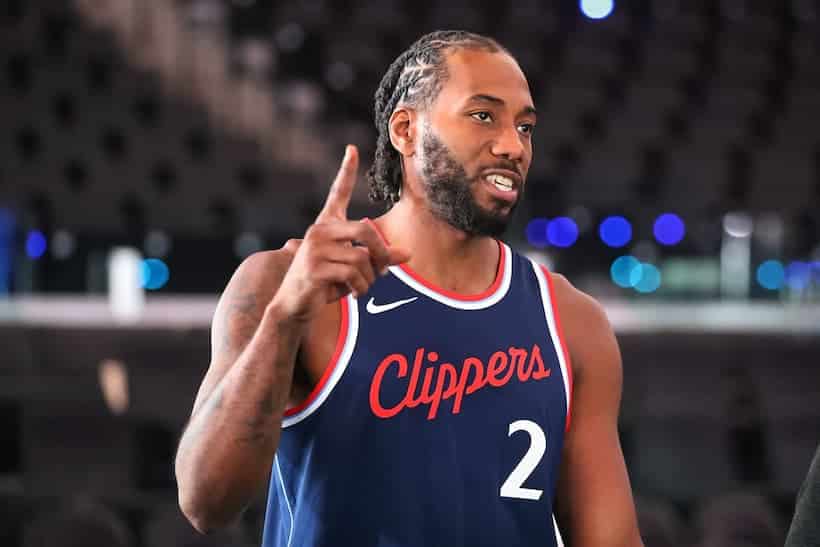Key Highlights
- Through two games against the Phoenix Suns, the Minnesota Timberwolves have an offensive rating of 118.8, which is 2.7 points higher than their regular season mark of 116.1
- Anthony Edwards is averaging 7.0 assists, up from 5.1 during the regular season
- Mike Conley Jr. has taken 25 shots, his third-most between any two consecutive games this season
For Anthony Edwards and the Minnesota Timberwolves, their regular season bouts facing the Phoenix Suns were a thorny, cramped, frustrating, 0-3 experience. In those contests, Edwards averaged 14.3 points on 44.2 percent true shooting — his worst clip against any Western Conference foe — and handed out 11 helpers to 10 giveaways. Phoenix won by 47 combined points. Each margin of victory was at least 10. The Suns gave Edwards and his running mates the business every time, including twice over the final 10 days of the regular season.
None of that’s mattered to open this first-round matchup. Minnesota is dealing that business right back, having routed Phoenix in Games 1 and 2 by 37 total points. Neither fourth quarter has really been competitive. The clean-up crews have closed both games. The Timberwolves remain two wins away from advancing, but they’ve certainly outclassed the Suns thus far.
As was the case all season en route to the No. 3 seed, their defense is paving the way. Per Cleaning the Glass, they’ve stymied Phoenix to a 100.0 offensive rating. They’re disintegrating dribble handoffs, bottling up spread pick-and-rolls, containing transition endeavors and cornering the Suns’ prolific scoring trio into ill-fated isolations against a gamut of well-qualified stoppers. Rudy Gobert is at the heart of it, playing drop, switching onto stars, coming to the level and turning the paint into a no-fly zone.
Minnesota’s won with this formula the past six months. It went 56-26 because of a historically great defense anchored by a historically great defender. That hasn’t changed.
What has changed is the offense. It’s why Minnesota is pummeling these Suns, which closed the year 7-3 versus a gauntlet of postseason opponents — featuring two demolitions of the Timberwolves — and seemed to unearth some cohesion down the stretch. Through two games, the Timberwolves’ 118.8 offensive rating is 8.4 points higher than the playoff average of 110.4. During the regular season, their 116.1 offensive rating was only 0.5 points above the league average (115.6). Two games do not make for an evolution, but that’s not what the playoffs are about. They’re about exploiting the varying schemes confronting you to win each night. Minnesota is doing that.
What’s Working For Minnesota Offensively?
Part of this stems from Edwards. Behind a 33-point Game 1, he morphed into a pulverizing pull-up shooter, dashing Phoenix’s chances with a slew of spectacle-worthy jumpers off the bounce. Ultimately, his Stephen Curry cosplay lasted only for an afternoon. He scored 15 points on 3-of-12 in Game 2 and yet, Minnesota’s offensive rating was still 113.0 (2.6 points above the playoff average). It repeatedly found avenues to punish Phoenix and keep the wheels turning, especially over the final 2.5 quarters (71 points over a 26-minute stretch).
During the regular season — along with Games 1 and 2 — Phoenix has prioritized slowing Edwards as a driver. He averaged 14.6 drives and 10.7 points from said drives this year. Those numbers dropped to 12.0 and 5.3 against Phoenix (12.0 and 5.5 through two playoff games). While Minnesota led the NBA in three-point percentage this season, it was just 20th in frequency and rosters plenty of shooters amid career years or with slow releases inviting delayed closeouts.
His Game 1 explosion didn’t arise because he solved the coverage, but rather because he caught fire and the Timberwolves schemed a little more space for him at times. Prioritizing Edwards’ downhill descents has meant bringing gap help from the wings and strongside stunts from the corners. He’s a locomotive slasher, powering past and through defenders rather than gliding around them with an elegant handle.
Crowds can cause trouble for him, particularly when his mercurial jumper won’t comply. Across three regular season meetings, he struggled to navigate that defense, often burrowing into a congested lane, forcing shots or spotting passing windows a beat late. Two turnovers in the first 2.5 minutes of Game 1 didn’t help matters either.
Following that choppy start, Edwards has tallied 14 assists and seven turnovers over his past 71.5 minutes. When Phoenix brings multiple bodies into his orbit, he simply swings passes to open teammates, who are executing prompt, sound decisions. This isn’t a case of Edwards expertly manipulating help with his eyes, body angles and cadence. But it doesn’t have to be. For five straight meetings with the Suns, they’ve decided somebody else will beat them offensively. In his first three games, he didn’t embrace the extra attention. He tried ignoring it, pile-driving through it, and pretending it didn’t exist, as if to bludgeon a different reality for himself.
On Saturday, he learned to trust the playmaking and the scoring eventually arrived. On Tuesday, the jumper wasn’t there. So, he sat back, kept the ball moving, and let his fellow Timberwolves maul Phoenix as he tallied a playoff career-high eight dimes (Sunday’s six matched his third-most). They did exactly that, and Edwards left a massive imprint on the offense, despite recording 15 points and 12 shots, both of which are lows for his 13-game playoff career.
With Edwards dialing back the scoring volume in Game 2 and Karl-Anthony Towns battling foul trouble both times, Minnesota’s needed the supporting cast to emerge. Jaden McDaniels, Naz Reid, Nickeil Alexander-Walker and Gobert have all enjoyed their moments, but Mike Conley Jr. has served as the most constant source of aggression. A 2-of-12 Game 1 soured some of it, but he returned with a vital 18 points (7-of-13 shooting) and four assists in Game 2. Twenty-five shot attempts are his third-most between two successive games this season, and his 12.5 per game are a clear jump from 8.5 during the regular season.
Conley is the Timberwolves’ foremost pick-and-roll conductor, second-best ball-handler and easily the apt partner for priming Gobert’s scoring opportunities (outside of putback duties). His aggression — or lack thereof — is a swing factor for their postseason hopes. Opponents, as the Suns have, avert attention toward Edwards. He receives the stingiest perimeter matchups and is focus of opposing game-plans. However far they travel in these playoffs, that will continue. It’ll leave Conley with some favorable scenarios, ones he must look to punish. In Game 2, he did.
He burned single coverage, exposed Phoenix’s sticky screen navigation and static ball-screen bigs, and showcased his chemistry with Gobert. During the second period, the Suns claimed their largest lead at 42-34 and threatened to open the game. That’s when Conley notched 12 of his 18 points and sprinkled in an assist for a slam from the Frenchman.
Minnesota’s frequented empty side and second-side Conley-Gobert actions all seasons when the defense tilts elsewhere — either prioritizing stars like Edwards and Towns or understandably ignoring Gobert off the ball, given his rigid offensive arsenal. It’s loved step-up and flare screens on the second side, which leverage Gobert’s screening and Conley’s passing, pull-up shooting and puppet master tempo.
My personal favorite from Game 2 was an after-timeout Wedge screen for Towns that flowed into a slot pick-and-roll. The Suns responded as Minnesota anticipated and the result was a slick, seamless finish for Towns. The ball-screen counter almost seems like the primary option, based on how Phoenix arranged its matchups and sought to neutralize the post touch. The Timberwolves’ size, personnel and schematics have been major advantages. This play encapsulates those divides.
This is what it looks like to exploit an opponent’s tendencies https://t.co/M6dnxEHomo pic.twitter.com/sdNAufV8ar
— Jackson Frank (@jackfrank_jjf) April 24, 2024
A couple minutes later, Minnesota again called a post-up for Towns on the left side, except Nurkic doesn’t try to scram switch it in support. Cognizant of another potential slot pick-and-roll, he stays near Gobert, and Towns’ rub screen opens a crease for McDaniels — whose release valve scoring was crucial and dependable in Game 2 (25 points, 10-of-17 shooting).
The Suns operate with a lot of predictable tendencies. On its own, that dynamic isn’t a death knell. Predictable and easy to stop aren’t always synonymous. But the Timberwolves appear ready for those tendencies, and Phoenix is yet to show much of a viable pivot away from them. When it’s tried, those adjustments have instead largely benefited their counterpart.
Minnesota’s defense will always persist to give it a chance. When the offense is also humming like this, though — especially without supernova shooting from Edwards — it plays in a league devoid of many peers. The Suns have experienced that firsthand over the past few days. It’s sunk them in an 0-2 hole, spotlighted glaring roster flaws, and lifted the Timberwolves toward their first series win in 20 years.






